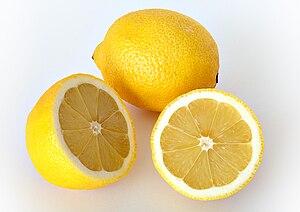Cookbook:Lemon
| Lemon | |
|---|---|
 | |
| Category | Fruits |
Cookbook | Recipes | Ingredients
Lemons are citrus fruit from the tree Citrus limon. They are cultivated primarily for their juice, though the pulp and rind are also used, primarily in cooking or mixology. Lemon juice is about 5% citric acid, which gives lemons a sour taste.
Lemons were not cultivated in the West until after the Arab conquests. They were cultivated in Genoa in the mid-fifteenth century, and appeared in the Azores in 1494. Lemons were once used by the British navy to combat scurvy, as they provided a large amount of vitamin C. The British navy originally thought lemons were overripe limes which they resemble and their sailors became known as limeys, not lemonys.
Both lemons and limes are regularly served as lemonade (natural lemon with water and sugar) or limeade, its equivalent, or as a garnish for drinks such as cola with a slice either inside or on the rim of the glass. Lemon juice is typically dripped onto battered fish dishes in restaurants in the United Kingdom and other countries—the acidic juice neutralizes the taste of amines in fish. Some like to eat lemons as fruit.
Lemon juice contains approximately 500 milligrams of vitamin C and 50 grams of citric acid per liter.
Zest[edit | edit source]
Lemon zest, when used as an ingredient, refers to shavings of the thin yellow outer skin of the lemon. The zest contains strong smelling oils which are used to flavor many baked goods. One can remove the zest from a lemon by using a small-holed grater, a microplane, or by carefully cutting the zest with a knife then mincing the results. Ideally, none of the white pith should be included with the zest. Be sure to scrub and wash the outer skin first to remove any remaining pesticide.
Recipes[edit | edit source]
Lemon recipes can be found in Category:Lemon recipes.